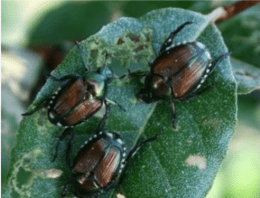By Raymond Cloyd, Professor and Extension Specialist in Horticultural Entomology/Plant Protection
We have received several inquiries from Southeast Kansas regarding black beetles causing damage to turfgrass. The black beetles are adults of the sugarcane beetle, Euetheola humilis (Burmeister) (Coleoptera: Scarabaeidae). The sugarcane beetle is native to the USA and is also called the rough headed corn stalk beetle.

Sugarcane beetle adults are 1/2 of an inch (13 millimeters) long, black, with distinct punctures or indentations that extend along the length of the body (Figure 1). The front legs have four serrations that allow the adult to tunnel through the soil. Sugarcane beetle adults are active in spring and feed during the night. Adults are attracted to light sources at night. Sugarcane beetle adults walk across the turfgrass in the early morning. Adults tunnel into the soil and remain in the soil during the day, which allows them to avoid predators and exposure to direct sunlight. Sugarcane beetle overwinters as an adult in the soil and there is one generation per year.
In the spring, females can lay between 30 to 60 eggs in the soil during their lifespan and then die after laying eggs. Sugarcane beetle larvae emerge (eclose) from eggs after approximately 10 days, and are white grubs with a red head and six yellow legs. There are three larval instars (stages between each molt) with the third instar larvae 1-1/4 of an inch (32 millimeters) long. Larvae are located in or below the thatch layer.
Larvae and adults can damage turfgrass by feeding on the roots, stems, and leaves (blades). Sugarcane beetle adults cause damage to warm season turfgrasses, such as, bermudagrass and zoysiagrass associated with golf courses, home lawns, and sod farms. In addition, sugarcane beetle adults can damage tall fescue lawns. Adults can also damage turfgrass when tunneling through the soil. In addition, mammals including: armadillos, birds, moles, and raccoons can cause substantial damage to turfgrass when searching for sugarcane beetle larvae and adults.
Sugarcane beetle populations can be managed by properly irrigating and fertilizing turfgrass to maintain health and vigor, which can mitigate damage caused by sugarcane
beetle larvae and adults. Furthermore, turn off all lights in the area at night to avoid attracting adults.
Pyrethroid based insecticides can be applied to manage sugarcane beetle adult populations in turfgrass. Apply insecticides when adults are initially present in the spring. Insecticides are more effective against adults that just emerged from overwintering than adults that are present later in the season.









 Fall of 2021 created significant issues with fall armyworms. Since that event, Dr. Raymond Cloyd has updated information on biology and control of this insect. It does not overwinter in Kansas, so it’s presence is dependent upon movement of moths from the south to our region. See the details here:
Fall of 2021 created significant issues with fall armyworms. Since that event, Dr. Raymond Cloyd has updated information on biology and control of this insect. It does not overwinter in Kansas, so it’s presence is dependent upon movement of moths from the south to our region. See the details here: This new blog video gives an update on a research project, a turf-related issue, or current concerns in the turf industry. Each one will be approximately 2 minutes long – you’ll see one periodically!
This new blog video gives an update on a research project, a turf-related issue, or current concerns in the turf industry. Each one will be approximately 2 minutes long – you’ll see one periodically!